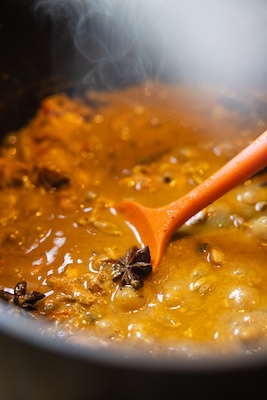Gluten-Free, Dairy-Free, Low FODMAP Biryiani
personal food
I have relatively complicated dietary constraints, which makes eating food from the Indian sub-continent very complicated.
Most of my Dad’s recipes from his place of birth in Pakistan begin by slicing up a lot of onions, and usually have liberal helpings of garlic in them — both of which I can’t eat. I’ve been experimenting for a while to create a biryani recipe that works for me.
It might be interesting to some other people with similar constraints, so I’m sharing it here.
Biryani Masala
This is the spice mix that you’ll marinate the meat of your choice in.
- 1 bay leaf
- 1 cinnamon stick
- 4 cloves
- 1 black cardamom pod
- 1 star anise
- 4 green cardamom pods
- 1 tsp cumin seeds
- 1/2 tsp black peppercorns
- 1/4 tsp fennel
Take these spices and grind them in either a pestle and mortar, or using an electric grinder.
Marinade
This recipe is best if you marinate the meat at least overnight. I actually recommend making the curry a day in advance, the flavours develop and it means that the day-of preparation is extremely easy.
If you’re using lamb or goat, then 550g seems sufficient. I usually would cook this in a smaller Le Creuset cast iron dutch oven — you can scale everything up for a larger portion. If you use chicken, 550g is sufficient if you have no bones. I sometimes use chicken thighs and leave the bones in which adds some more flavour.
- 550g meat of your choice.
- 115g almond milk yoghurt (I use Kite Hill)
- 1 tbsp garlic oil (garlic infused oil is safe for low-FODMAP diets, and this gives us some of the garlic flavour back).
- Biryani masala (see above)
- 1 tsp ground coriander.
- 1/2 tsp ground cumin.
- 1/2 tsp red chilli powder.
- 1/4 tsp tumeric
- 1/4 tsp nutmeg
- 2 tsp salt
Biryani
The actual curry!
- Whole spices for this step
- 3 bay leaves
- 5 cloves
- 5 black cardamom pods
- 6 star anise
- 6 green cardamom pods
- 2 cinnamon sticks
- 1/2 tsp cumin seeds
- 1/2 tsp black peppercorns
- 3 Poblano peppers (these are substituted for onions, check whether they have any heat so as to not get the spicing wrong in the dish), finely sliced.
- A thumb-sized piece of ginger, minced.
- 1 tomato
- 1 green chilli pepper
- 1 tsp garam masala
- 350g long grained basmati rice.
Method
- Make up the biryani masala by grinding all the spices. Add it to the other marinade ingredients. Chop the meat that you’re using into cubes (I tend to find that a bit bigger cubes works better), and marinade the meat — ideally overnight — in the fridge.
- Over a medium heat, add oil to a large pan and add the poblano peppers. Cook for 15-minutes, or until they are soft and look a bit like you’d expect cooked onions to. It’s worth being careful to avoid them burning.
- Once done, add 100ml of water to the pan to deglaze it. Once evaporated add all the whole spices, and ginger and cook for two minutes.
- Add the meat and marinade and brown it (this takes 5 minutes or so, depending on the amount of meat). It’s best to start with the meat at room temperature (get it out of the fridge before you start chopping peppers and ginger). Once browned add the tomato and green chilli pepper.
- Add water to 1/3 of the way up the meat layer and simmer, stirring every 5-10 minutes for at least 30 minutes. I tend to find that it depends on the meat how long this step should go for. Once done, raise the heat to get it to be a thick consistency and add the garam masala and salt.
- At this point, you can leave the curry overnight to develop more flavour — or use it straight away.
- When you’re ready to make the biriyani — wash and drain the rice, ensuring that the water draining off runs clear. Cook the rice by adding it to a pan with the suggested amount of water (1 measure of rice = 1.5 measures of water), but undercook it compared to how you would eat it directly. You want the rice to be just soft, but not overcooked. I find 5 minutes boiling is sufficient for this.
- Lightly rub olive oil on the inside of your dutch oven, and add one layer of rice. Sprinkle over one tea spoon of garam masala. If you have kept the curry overnight, then warm it in a pan. Layer on the curry, and then another layer of rice. Sprinkle the top layer of rice with garam masala, and add 25ml of water. Place sliced lemons, whole mint leaves, and whole coriander leaves on top.
- Place a damp tea towel or tin foil between the dutch oven and its lid to seal the steam in. Heat the dutch oven for 5 minutes to build steam inside it at high heat, before turning the heat down to low and steaming for 20 minutes. Let rest for 10 minutes.
- Serve with raita (yoghurt, salt to taste, garam masala, paprika).
Enjoy!
This recipe was heavily influnced by this teafortumeric recipe.
